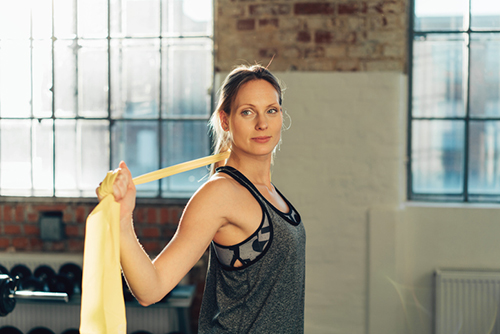What is Frozen Shoulder?
Frozen Shoulder, clinically known as Adhesive Capsulitis, is the stiffening of the shoulder due to scar tissue, which results in painful movement and loss of range of motion. According to OrthoInfo, hallmark signs of adhesive capsulitis are severe pain and being unable to move your shoulder. It is not associated with a specific underlying condition and mostly affects adults between the ages of 40 and 60 years old.

What Are Signs & Symptoms of Frozen Shoulder?
Frozen shoulder tends to get better, although full recovery may take up to 3 years. In some more serious cases, surgery may be needed. However, physical therapy, with a focus on shoulder flexibility, is the primary treatment recommendation for frozen shoulder. Typically frozen shoulder follows three stages:
1. Freezing Stage: “The Painful Stage”
This stage is characterized by shoulder pain with movement, generalized ache, and muscle spasms. These symptoms may worsen at night. Typically lasts 6-9 months.
2. Frozen Stage: “The Adhesive Stage”
This stage is characterized by increased stiffness and restriction of movement, however, there is less shoulder pain. Typically lasts 2 to 6 months.
3. Thawing Stage: “The Recovery Stage”
This stage is characterized by decreased shoulder pain and the ability to move slowly improves. Typically, full range of motion and strength return within 6 months to two years.
If you are experiencing any of the symptoms above, visit your doctor or physical therapist to be properly diagnosed.
What Are Exercises To Loosen Shoulders?
As mentioned, physical therapy is the top treatment recommendation for frozen shoulder. There are a variety of PT exercises that you can do at home to help recover. Of course, you should also visit a physical therapist who can develop a specific treatment program developed around your personalized needs.
- Passive Stretch: This stretch helps to increase the range of motion. To complete this stretch, stand in a doorway and bend the affected arm's elbow to 90 degrees to reach the door jam. Hold on to the frame while rotating your body & hold for 30 seconds.
- Towel Stretch: This stretch is performed to loosen the front of your shoulder. To complete this stretch, hold one end of a three-foot-long towel behind your back and grab the opposite end with your other hand. Hold the towel in a horizontal position. Use your good arm to pull the affected arm upward to stretch it. A gentle stretch should be felt in the front or side of your shoulder. Once you feel a stretch in your shoulder, hold the position for two or three seconds, and then slowly release the stretch.
- Finger Walk: To complete this exercise stand upright with your shoulder about 2 feet from the wall. Raise your arm to shoulder level with your elbow slightly bent and gently “walk” your fingers up the wall. Stop once you've reached the highest point you can comfortably go, and slowly lower your arm. If possible, it is beneficial to perform this exercise 10 to 20 times a day.
- Crossover Arm Stretch: To complete this exercise you can be standing or sitting. Gently pull one arm across your chest just below your chin as far as possible without causing pain. Hold for 30 seconds. Relax and repeat.
- Resistance Band Strengthening: There are a variety of exercises that can be performed with a resistance band. The best stretch for a frozen shoulder is to use the band to strengthen your shoulder in flexion, abduction, internal and external rotation, and extension. These can be performed by tying the band to a doorknob and pulling the band toward your body two or three inches and hold for five seconds.
Shoulder Exercises for Shoulder Pain
If you have been experiencing pain in your shoulders, these five exercises will help alleviate shoulder pain. These shoulder pain exercises can quickly be done throughout your day and can help improve your shoulders.
Exercises to Prevent Shoulder Injuries for Baseball Players
One of the most used body parts while playing baseball is the shoulder, and one of the most crucial muscles of the shoulder is the rotator cuff. These eight shoulder exercises will help you stay on the diamond all season long.
JAG Physical Therapy is proud to offer treatment options for frozen shoulder. For more information or to make an appointment to meet with one of our therapists please contact us here.
Learn More About Shoulder Physical Therapy From JAG PT:
